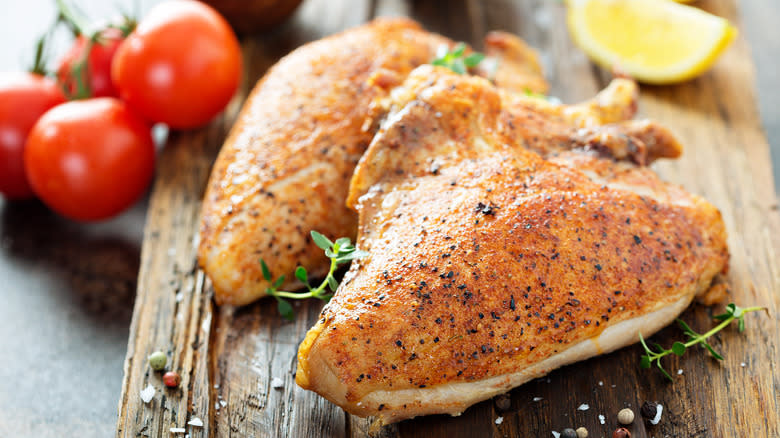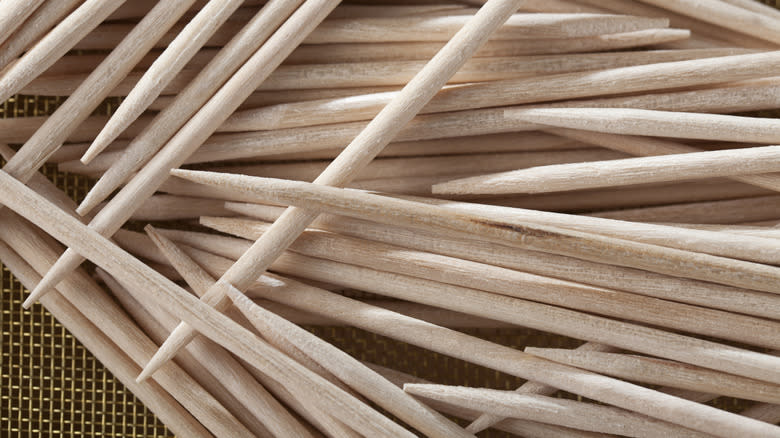The Easy Toothpick Trick For Perfectly Roasted Chicken Breast

Roasting chicken breasts with the skin on is a good idea. Roasting chicken breasts with the skin pinned in place with a few toothpicks is an excellent idea
Almost anyone who's cooked a whole or cut-up chicken knows that the skin on the breast acts differently than the skin on dark meat, such as drumsticks and thighs. For one thing, the skin on chicken breasts is less fatty and robust than the skin covering the thighs. For another, the skin on a chicken breast will shrink as it cooks, exposing the meat, and any spice rubs you might have stuffed between the skin and the meat. Our advice? Pin that skin in place with a few toothpicks to prevent it from shrinking, and reap the rewards.
Why take this extra step? Because this toothpick trick neatly accomplishes several things. With the skin on, chicken breasts become self-basting thanks to the layer of fat between the meat and skin that renders during the cooking process. Also, any yummy spice rub you've stuffed between the breast and skin will not be dried out by exposure. Best of all, the skin is virtually guaranteed to get lovely and crisp -- as lovers of fried chicken skin will tell you.
Read more: 15 Tricks For Making The Most Crispy Chicken Thighs Ever
Pin The Skin For Juicier, More Flavorful Meat

It's not necessary to soak the toothpicks before using them, and they can be removed once the cooked chicken breasts have rested. You don't need to stab them in too deeply, either -- just enough to keep the skin in place. Many people prefer chicken breast because it's leaner than the thigh, but it's this lowered fat content that can make cooked boneless chicken breast turn out dry. Cooking chicken breasts with the skin on adds a layer of protection from the oven's drying heat, thus retaining moisture during the cooking process.
Keeping the breast skin in place with toothpicks not only assures an even coverage of this protective layer but also pokes holes in the meat for the rendering fat to seep into. What does that accomplish? Much, because fat enhances flavor as well as juiciness -- good news for your oven-baked chicken breasts! While it's a good idea to remove chicken skin when slow cooking, it isn't when baking. So if you don't like skin, you can just discard the pinned skin once the breasts are cooked through. But if you consider crispy chicken skin a delicacy, the toothpick trick will hook you up in that department, too.
Crispier Skin The Toothpick Way

Because the toothpick trick allows hot rendered fat to coat the outside of the skin, it's essentially frying it to a crisp. Those holes in the skin created by the toothpicks work two ways: They baste the meat while also basting the skin. This is great news for those who like deep-brown, crispy skin -- think of it like oven-frying the chicken breast.
You might have noticed that some recipes for oven-roasted whole chicken call for smearing the skin with butter or olive oil. The toothpick trick obviates this extra step, because the rendering chicken fat will accomplish the same goal. There are a couple more tricks besides skin-pinning for ensuring that the skin of your roasted chicken breast is super crispy.
First, make sure you dry the breast thoroughly: Your goal is to render fat, not create steam. Moisture might be awesome for the meat, but it's a deal-breaker on the skin. Second, when roasting skin-on breasts, keep your oven temperature consistent and decently hot: around 425 degrees Fahrenheit. With the skin pinned on, you can cook on high heat without fear of drying these little darlings out.
Read the original article on Daily Meal


